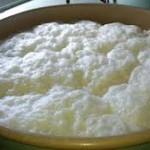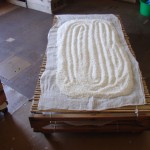 In a recent newsletter about aged sake, I read about how the system used to tax sake brewers that was in place from the late 1800s until just after WWII was one that indirectly but strongly discouraged brewers from even thinking about trying to age sake. While this system is long defunct, it left the industry with decades of catch-up self-education on the results of aging, yet at the same time shaped the sake we enjoy today.
In a recent newsletter about aged sake, I read about how the system used to tax sake brewers that was in place from the late 1800s until just after WWII was one that indirectly but strongly discouraged brewers from even thinking about trying to age sake. While this system is long defunct, it left the industry with decades of catch-up self-education on the results of aging, yet at the same time shaped the sake we enjoy today.
In short, back then brewers had to pay tax to the government on sake as soon as it was pressed, in other words, as soon as the rice lees has been filtered away after fermentation was complete, i.e. as soon as it became proper sake. Note, it did not matter whether the stuff ever got sold. As soon as it came into existence, the government demanded its due taxes.
The problem was – especially back then – what if it went bad after that, or if a tank leaked or it got spilled. Too bad, intoned the Ministry of Taxation. And so ensued clandestine tactics.
In order to make sure that every taxable drop was accounted for, the government would measure everything at every stage. (They still do, more or less, today.) They operated on the basic assumption that brewers were fundamentally trying to avoid paying taxes. And so genmai (unmilled, “brown” rice), white (i.e. milled) rice, koji, liters of moto (yeast starter), and liters of moromi (fermenting mash) all had to be carefully measured and recorded for each batch.
 After reading the article, I spoke to the author, a now semi-retired (one never really leaves the sake world!) former director of a large-ish, dignified and diverse brewery of some means. He explained the details of how things proceeded.
After reading the article, I spoke to the author, a now semi-retired (one never really leaves the sake world!) former director of a large-ish, dignified and diverse brewery of some means. He explained the details of how things proceeded.
“Back then,” he began, “it was a game, really. Everyone was doing it!” His smile was laced with some embarrassment, much like a kid caught with his hand in the cookie jar, as he continued.
“In truth, we felt we had to – or at least had the right to – make up for what was sure to be at least some inevitable losses, be it from inadvertent spillage or leakage, sake going bad from incomplete pasteurization, or just other unexpected mishaps. We had to at least make up for what we were sure we would lose!”
So the brewers would try to hide part of the moromi, or hide the sake as it was being pressed, and went w-a-y out of their way to come up with creative ways of doing this. And of course, there were in fact occasionally incidences of the moto or moromi spilling or leaking. But it was hard to convince the tax man of the veracity of this.
 They would have none of that nonsense, and would scour the kura looking for where it was being hidden. Never limiting their searches to the main brewing facilities, they would go into the living quarters of the kuramoto (the owning family) and poke around in closets and storage rooms, and if they did not find anything there, they would search for the unaccounted volumes in the homes of neighbors and relatives. It seems to have been quite the game!
They would have none of that nonsense, and would scour the kura looking for where it was being hidden. Never limiting their searches to the main brewing facilities, they would go into the living quarters of the kuramoto (the owning family) and poke around in closets and storage rooms, and if they did not find anything there, they would search for the unaccounted volumes in the homes of neighbors and relatives. It seems to have been quite the game!
The drag for the brewers was that, again, from time to time there were real accidents. The wooden tanks in use back then might have cracks, so that months after filling a tank with sake for maturation, they could open the tank and find it empty. Whoops! Or the wooden stopper at the bottom, if not properly inserted, might pop out and a whole tank’s worth of ambrosia could disappear in a couple of hours. Or warmer-than-expected temperatures could spoil a sake not yet pasteurized. Yet they could expect no redress from the tax man for this. Hence the perceived need to pre-emptively account for that via whatever means available to them.
And this is why the Zoukokuzei system was so hard on the brewers. Fortunately, the government is more reasonable these days, and brewers are now taxed on what they sell and when they sell it. And this has opened up brewers’ willingness to at least experiment with aging sake. We can at least understand their reticence of brewers long ago, since once they have paid taxes, if the aging thing did not go well, they were out a significant amount.
This seems to me to have affected sake as we enjoy it today. Very little sake is matured today, much less than might have been had brewers been permitted the leeway to experiment over the decades. As such, sake has developed in such a way that it is best enjoyed relatively young, albeit with some exceptions.
And I, for one, am OK with that.







